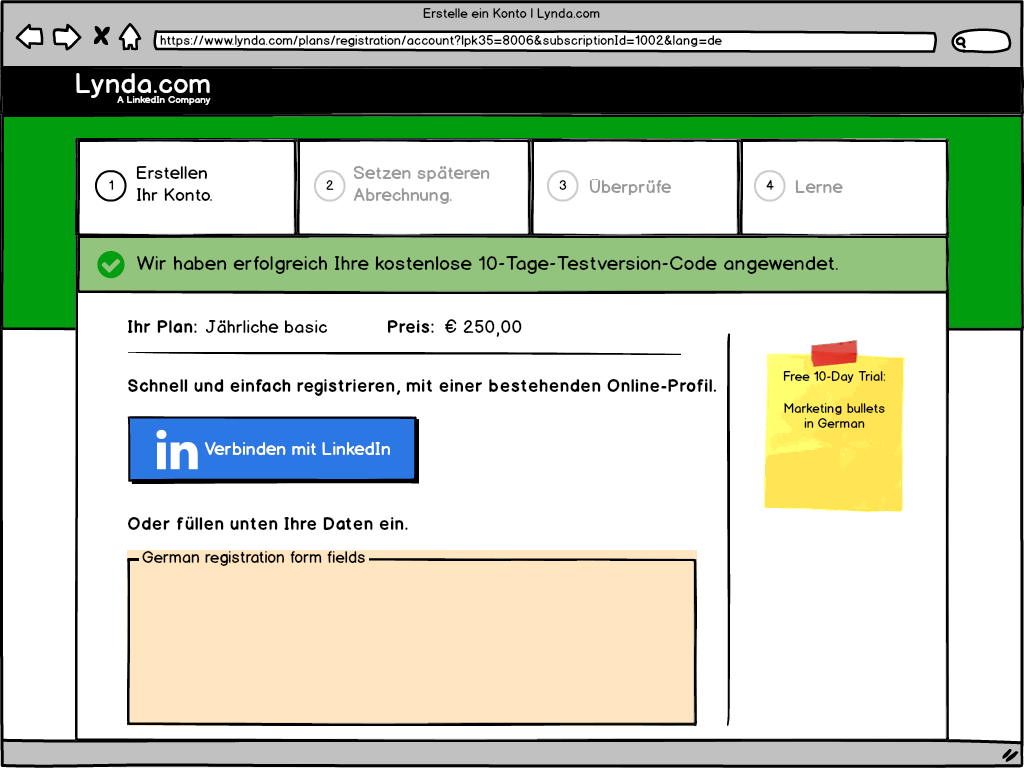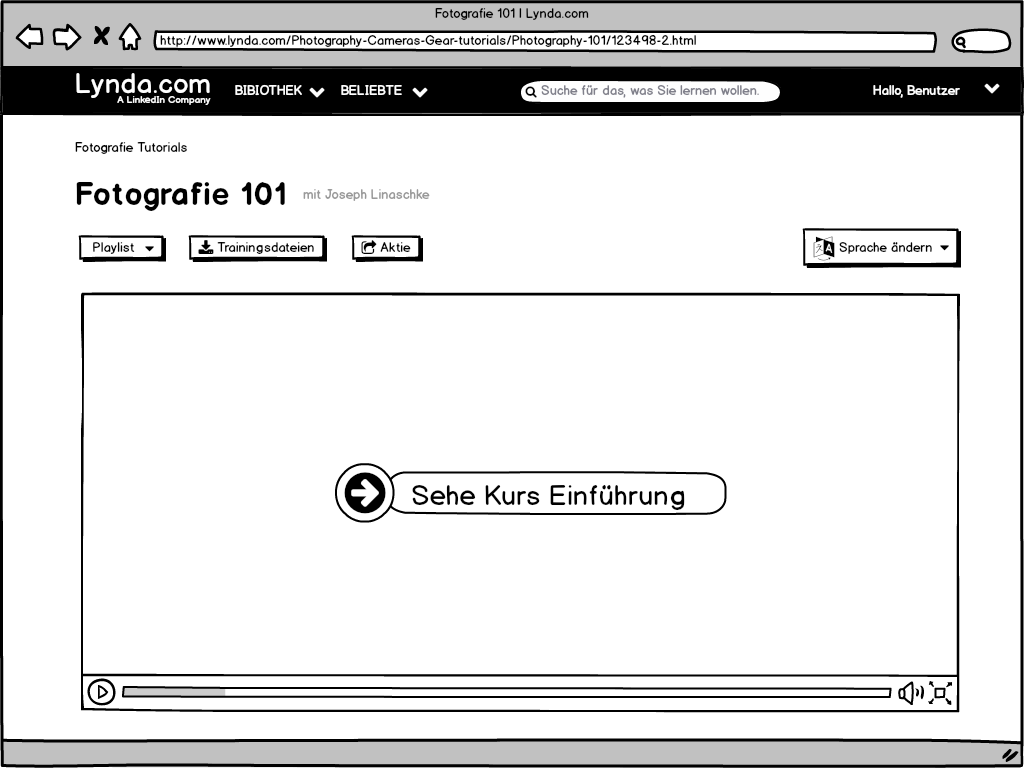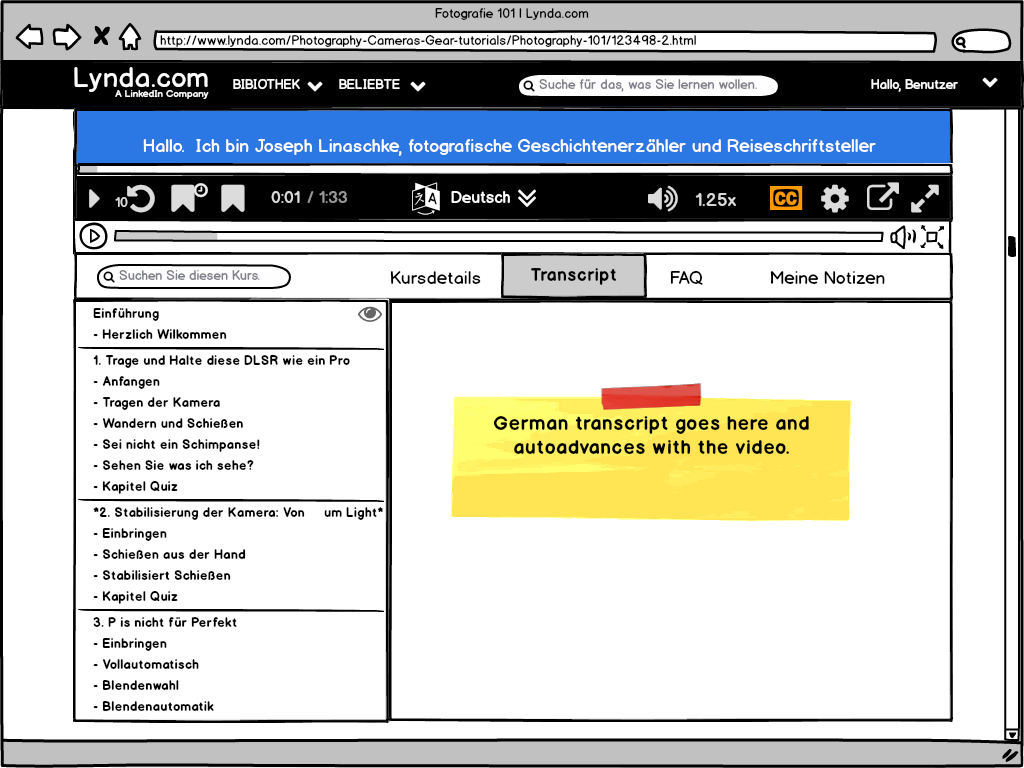Product Requirements Document (PRD)
Prepared by: Lee Nau (lee@leenau.com) -
Title
Global Lynda.com - Lynda.com Site and Course Internationalization
Stakeholders
- Vice President of Marketing
- Vice President of Engineering
- Director of Content
- Director of Business Development
- Customer Support Manager
Status
Lynda.com currently offers non-English content only on video2brain.com, a company Lynda acquired in 2013.
Background
Context
With an increasing amount of traffic from outside the United States, using languages other than English, Lynda.com now has an opportunity to expand offerings for customers in foreign markets. With LinkedIn's 200 million foreign users, Lynda.com is in a unique position to lead the online education industry.
Product
The current product includes verbatim course transcripts and closed captioning based on the transcripts, which can be toggled on. The closed caption subtitles are available to support people with hearing difficulties or people with English fluency challenges.
Competitors
- Udemy offers neither subtitling in foreign languages or closed captioning for the hearing challenged. Courses are contributed by individual course contributors that sell their courses through Udemy.
- Udacity's video content is hosted on Youtube and uses Youtube's closed captioning and subtitling feature. With an option for Google's machine translation, this feature can, in some languages, have some accuracy challenges. Google's automatic translation misses the mark frequently on technical material and is inferior to human translated text.
- Coursera offers select content subtitled in selected languages, depending on the course. Coursera also offers complete courses in foreign languages, many of which are contributed by universities and corporations in the country that speaks that language.
- Code School offers closed captions in English only.
Metrics
Lynda.com does not currently offer the user experience in languages other than English, nor do they offer the course transcripts in any other languages. Therefore, the current user base is zero.
Using the 28% LinkedIn Growth rate as a benchmark (and similar numbers were reported for Lynda.com in 2013, a target growth rate of 20% YOY with 25% in foreign markets could add $1M/year to the Lynda.com revenue numbers. More aggressive marketing in foreign markets could drive the number up with minimal impact to engineering.
Users
- This feature will help Lynda.com attract a new international audience for their well-produced and highly acclaimed coursework.
- Current foreign language users who read the transcripts in English would get materials in their own language.
- Some current users work around Lynda.com's lack of non-English subtitles by making their own dubbed soundtracks with Google Translate and the English transcript. Ricardo J's tutorial: Traduzindo para Português os vídeos e os textos da Lynda.com.
Projected Phases
- Provide subtitles in target languages for target regions (Simplified Chinese, Japanese, and Korean for APAC; French, German, Italian, Spanish, Portuguese, and Russian for EMEA; French, Spanish, and Portuguese for Americas) for the 20 most-demanded courses in each language, using Smartling or similar vendor.
- Build foreign language user experience, targeted at desktop and mobile users per language, using Smartling or similar solution.
- Coordinate with finance and engineering teams to ensure that foreign language users in target markets have an option to pay for their subscription in their currency.
- Begin producing language-specific foreign language content and documentation for use in those markets.
Success Metrics
Measuring success with initially involve benchmarking adoption, engagement, and completion rates for foreign-subtitled courses against current per-country completion rates for the courses as they are before this project.
For each target market:
- Top 20 most initiated courses in English, from users in target market, whose primary browsing language is not English.
- Completion rate for foreign language speakers for courses in English.
- Completion rate for foreign language speakers for courses in English, with subtitling in their language.
- Number of related subtitled courses foreign language speakers initiate after completing at least the introductory chapter in courses with NEST (Non-English Subtitles).
Overall success metrics:
- Increased clickthroughs for advertisements on LinkedIn and other channels.
- Increased number of trials by people whose browsing language is not English.
- Increased number of subscribers from target markets.
- Increased engagement by subscribers from non-English speaking countries, whose primary browsing language is not English.
Epics
In Scope
- As a non-English speaker, in order to complete the courses more easily, I want to see courses subtitled in a language I understand.
- As a non-English speaker, in order to work with the site in a language I'm comfortable with, I want the Lynda.com user interface internationalized.
- As a non-English speaker, I'd be thrilled to have the option to complete courses with an audio soundtrack in my prefered language.
Out of Scope
- As someone who lives outside of the US or the UK, I'd like to be able to subscribe to the service in my local currency.
Requirements
- 20 Initial Courses for each Target Language
- Group commonalities between languages.
- Course subtitling.
- Video subtitling can be installed in each video, swappable per user language preference.
- Video subtitle control toggle.
- User can toggle on subtitles with a selector that shows all the languages in which subtitling is available on a particular course.
- User profile prefered language setting.
- User can set a language preference for prefered subtitling or course / video promotion (and to receive special emails / promotions in the target language).
Messaging ideas per requirements above.
- Course ad messaging examples:
- WordPress -> landing page for WordPress Essential Training (2015) for target language
- "Do you want to learn WordPress? [LINK: 'Starting learning today - FREE!']"
- Mac OS X El Capitan -> landing page for Mac OS X El Capitan Essential Training for target language
- "Get up to speed with new features in Mac OS X. [LINK: 'Start learning today - FREE!']"
- Github -> landing page for Up and Running with Github
- "Learn Github and contribute to the open source movement. [LINK: 'Start learning today - FREE!']"
- Adobe Illustrator CC (2015) -> landing page for Illustrator CC for target language.
- "Learn to design with Adobe Illustrator CC. [LINK: 'Start learning today - FREE']"
- Course subtitling.
- Promotion language -> landing page in target language:
- "Translated subtitles in {language} are available for {list of courses}. The number of courses is growing every day." [LINK: Comprehensive list for courses with translated subtitles in {language}]
- User account page -> from landing page above.
- "Set my prefered language to {language} and show courses with audio or subtitles in {language} at top of search results."
- Individual course modal.
- "Your language preference is set to {language} and new subtitles are available for this course. [CHOICE: 'Switch now?']"
- Video toggle switch, with some kind of icon:
- "Switch subtitles to {language selector choices}."
Design
Landing Page
This landing page features much of the content on the existing Lynda.com
landing page with a callout for German subtitles.

Sign Up
Clicking Kostenlose Registrierung takes the customer to a sign up page
that features a price in the local currency (if available, otherwise US
Dollars) and form fields in the local language.

Profile with Language Preference
From the sign up, the customer can edit their profile and preferences,
including changing the language preference, as shown here. Note that the
entire user interface is in the local language.

Course (Photography 101)
An example of a course with controls and user interface elements in another
language (German, in this example), allows the customer to initiate a course
or video with the controls.

Course Control Details (Photography 101)
The customer has started the course here. Note the subtitling on the
video in German in blue at the bottom of the video panel, with a selector
dropdown for "Deutsch" in the video controls. Chapter titles below are in
German and the Transcript automatically advances as the video plays, the way
it currently works in English.

Timeline & Release Planning
Phase 0: Validation
- Identify most requested/started languages for users whose primary computing
environment is in Spanish, whether located in the United States or other
Spanish-speaking countries.
- Consider the six most populous Spanish-speaking countries as target foreign markets: Mexico, Spain, Colombia, Argentina, Peru, and Venezuela.
- Also target U.S. Spanish speakers.
- Translate subtitles for top 20 courses, aggregated across all markets.
- Collect metrics and check engagement: caption switch clicks, course chapter completion, course completion, course dropout rate.
Phases 1 - 4: Stepped Phases
- For each language, identify key targets for marketing campaigns.
- Translate subtitles for top 20 courses in each language.
- Adjust based on metrics from A/B tests, customer interviews, and surveys.
Release Phases
- Announcements on LinkedIn, Facebook, and Twitter in target languages for target market, including sponsoring posts in target countries.
- Create landing pages for each target language/market combination to rank on relevant search engines and drive Call-to-Action clicks through to localized sign up flow (i.e.: https://es.lynda.com/lp/bienvenidos/ ).
- Craft HTML email campaign material to advice endusers with language preferences selected about newly translated subtitled (or, later, voice) courses.
Rollout and A/B Testing
- Drive 10% search engine cohort to multiple landing pages to test language for conversion potential.
- Test new UI components on videos and profile pages to ensure comprehensibility, both in language and user interface.
- Gradually increase cohort over three months, rolling in landing experience to international users.
Checklists
- Identify target markets per language per phase.
- Best to target largest economies first.
- Identify 20 most sought-after courses per market.
- Translate each of the 20 most sought-after languages.
- Translate using human translations with Smartling.
- Roll new translations into courses as togglable subtitle option in each targeted course.
- A/B test placement of UI language toggle widget for each course.
- Build landing pages and marketing material.
- Internationalize Lynda.com homepage and build landing pages per language and market:
- http://es.lynda.com/bienvenidos - Target ccTLDs or prefixes for landing pages.
- Test audience engagement with Optimizely.
- Open subtitle toggle option to all customers globally for each language.
- Introduce messaging on social media platforms, on LinkedIn, Twitter, and Facebook.
- Repeat 2 - 4 with next 20, 50, 100 courses, if possible.





